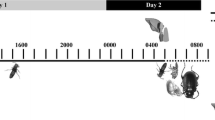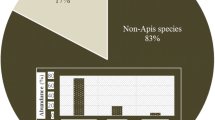Abstract
To assess the impact of the carpenter bee, Xylocopa olivacea Fabricius 1787, on the pod and seed yields of Cajanus cajan (L.) Millsp. 1900, in this study, its foraging and pollinating activities were examined in Nkolbisson during two seasons (July 2008-January 2009 and June-December 2009). Observations were made on 180 inflorescences per treatment. The treatments included unlimited floral access to all visitors, bagging of flowers to prevent access to all visitors, and floral access to limited visits by X. olivacea only, fn addition, information on all floral visitors was recorded. The carpenter bee’s seasonal rhythm of activity, its foraging behaviour on flowers, its pollination efficiency, the fruiting rate (Fr) and the number of seeds per pod were recorded. Nineteen species of insects were recorded visiting the flowers of C. cajan. Chalicodoma cincta cincta was the most prominent one, followed by X. olivacea, Apis mellifera adansonii, Megachile bituberculata and Xylocopa albiceps, and the bees were the most frequent floral visitors. Xylocopa olivacea mainly foraged for nectar and pollen and its foraging speed was 11.75 flowers/min. The Fr, the number of seeds/pod and the percentage of normal seeds of unprotected inflorescences were significantly higher than those of inflorescences protected from insects. The foraging activity of X. olivacea resulted in a significant increase in the Fr by 22.26%, as well as the number of seeds/pod by 34.98% and the percentage of normal seeds by 12.09% in the two study years. Placing X. olivacea nests close to C. cajan fields is recommended to increase pod and seed production in Cameroon.
Similar content being viewed by others
References
Basualdo M., Bedascarrasbure E. and De Jong D. (2000) Africanized honey bees (Hymenoptera: Apidae) have a greater fidelity to sunflowers than European bees. Journal of Economic Entomology 93, 304–307.
Bramel J., Kiran S., Reddy J., Ford-Lloyd B. and Chancra S. (2004) Degree and distribution of pigeon pea landrace morphological diversity in traditional cropping systems in Andhra Pradesh, pp. 1–45. In Assessing the Risk of Losses of Biodiversity in Traditional Cropping Systems: A Case Study of Pigeon Pea in Andhra Pradesh (edited by P. J. Bramel). International Crops Research Institute for the Semi-Arid Tropics, Patancheru.
Carreck N. L., Williams I. H. and Little D. J. (1997) The movement of honey bee colonies for crop pollination and honey production by beekeepers in Great Britain. Bee World 78, 67–77.
Changaya A. G. (2007) Development of high yielding pigeonpea (Cajanus cajan) germplasm with resistance to Fusarium wilt (Fusarium udum) in Malawi. PhD Thesis, University of Kwazulu-Natal, South Africa. 191 pp.
Choudhary A. K., Iquebal M. A. and Nadarajan N. (2012) Protogyny is an attractive option over emasculation for hybridization in pigeonpea. Journal of Breeding and Genetics 44, 138–148.
Dag A., Zipori I. and Pleser Y. (2006) Using bumblebees to improve almond pollination by the honeybee. Journal of Apicultural Research 45, 215–216.
Damaris A. O. (2007) The potential of pigeonpea (Cajanus cajan (L.) Millsp.) in Africa. Natural Resources Forum 31, 297–305.
Eneche E. H. (1999) Biscuit-making potential of millet/ pigeonpea flour blends. Plant Foods for Human Nutrition 54, 21–27.
Gallai N., Salles J.-M., Settele J. and Vaissière B. E. (2009) Economic valuation of the vulnerability of world agriculture confronted with pollinator decline. Ecological Economics 68, 810–821.
Greenleaf S. S. and Kremen C. (2006) Wild bees enhance honey bees’ pollination of hybrid sunflower. Proceedings of the National Academy of Sciences USA 103, 13890–13895.
Gupta D. N., Parab A. A., Mehta H. R. and Goyal R. (2001) Evaluation of nutritive value of promising genotypes and horsegram in Konkan. Journal of Phytological Research 14, 143–146.
Heard T. A. (1999) The role of stingless bees in crop pollination. Annual Review of Entomology 44, 183–206.
Jacob-Remacle A. (1989) Comportement de butinage de l’abeille domestique et des Abeilles sauvages dans des vergers de pommiers en Belgique. Apidologie 20, 271–285.
Karachi M. and Zengo M. (1998) Legume forages from pigeonpea, leucaena and sesbania as supplements to natural pastures for goat production in western Tanzania. Agroforestry Systems 39, 13–21.
Kingha T. M. B., Tchuenguem Fohouo F.-N., Ngakou A. and Brückner D. (2012) Foraging and pollination activities of Xylocopa olivacea (Hymenoptera, Apidae) on Phaseolus vulgaris (Fabaceae) flowers at Dang (Ngaoundere-Cameroon). Journal of Agricultural Extension and Rural Development 4, 330–339.
Klein A. M., Vaissière B. E., Cane J. H., Steffan-Dewenter I., Cunnigham S. A., Kremen C. and Tscharntke T. (2007) Importance of pollinators in changing landscapes for world crops. Proceedings of the Royal Society B274, 303–313.
Kudom A. A. and Kwapong P. K. (2010) Floral visitors of Ananas comosus in Ghana: a preliminary assessment. Journal of Pollination Ecology 2, 27–32.
Madeley J. (1995) Sahel’s salvation: African f arming and food processing, May/June 1995. Alain Charles Publishing Ltd, London, UK.
Martins D. J. (2007) Pollination Profile of Pigeonpea (Cajanus cajan) in Mwanza, Tanzania. Global Survey of Good Pollination Practices. Food and Agriculture Organization of the United Nations, Rome.
Martins D. J. (2008) Pigeon Pea (Cajanus cajan) in Mwanza, Western Tanzania. Initial Survey of Good Pollination Practices. Food and Agriculture Organization of the United Nations, Rome.
Martins D. J. (2013) People, plants and pollinators: uniting conservation, food security, and sustainable agriculture in East Africa, pp. 233–238. In Conservation Biology: Voices from the Tropics, 1st edn. (edited by N. S. Sodhi, L. Gibson and P. H. Raven). John Wiley and Sons Ltd, New York.
Mensah B. A. and Kudom A. A. (2011) Foraging dynamics and pollination efficiency of Apis mellifera and Xylocopa olivacea on Luffa aegyptiaca Mill (Cucurbitaceae) in Southern Ghana. Journal of Pollination Ecology 4, 34–38.
Mugula J. K. and Lyimo M. (2000) Evaluation of the nutritional quality and acceptability of sorghum-based tempeh as potential weaning foods in Tanzania. International Journal of Food Sciences and Nutrition 51, 269–277.
Onofiok N., Nnanyelugo D. O. and Ukwondi B. E. (1996) Usage patterns and contribution of fermented foods to the nutrient intakes of low income households in Emene, Nigeria. Plant Foods for Human Nutrition 49, 199–211.
Otieno M. (2010) Assessing the Drivers of Pollinator and Natural Enemy Communities in Pigeonpea and Field Bean Crops. Thesis of Doctorat/PhD, University of Reading, United Kingdom. Available at: https://doi.org/www.google.cm/?gws_rd=cr&ei=az0oU-6gH6OV7Qbt_YEY#q=Otieno+M.+(2010)+Assessing+the+Dri-vers+of+Pollinator+and+Natural+Enemy+Commu-nities+in+Pigeonpea+and+Field+Bean+Crops&start=10 (accessed 19 March 2014)
Otieno M. (2013) Functional responses of bee communities to local management and landscape structure in pigeon pea cropping system in Kenya. In New Frontiers in Tropical Biology: The Next 50 Years. (A Joint Meeting of ATBC and OTS). The Association for Tropical Biology and Conservation (ATBC), 2013.
Otieno M., Woodcock B. A., Wilby A., Vogiatzakis I. N., Mauchline A. L., Gikungu M. W. and Potts S. G. (2011) Local management and landscape drivers of pollination and biological control services in a Kenyan agroecosystem. Biological Conservation 144, 2424–2431.
Pando J. B. (2013) Activité de butinage et de pollinisation de Apis mellifera, Chalicodoma cincta et Xylocopa olivacea sur les fleurs de Cajanus cajan, Phaseolus coccineus et Vigna unguiculata à Yaoundé (Cameroun). Thèse de Doctorat/PhD, Université de Yaoundé I, Cameroun. 210 pp.
Pando J. B., Tchuenguem Fohouo R-N. and Tamesse J. L. (2011a) Pollination and yield responses of pigeon pea (Cajanus cajan L. Millsp.) to the foraging activity of Chalicodoma cincta cincta (Hymenoptera: Megachilidae) in Yaoundé (Cameroon). Journal of Animal and Plant Science 11, 1346–1357.
Pando J. B., Tchuenguem Fohouo F.-N. and Tamesse J. L. (2011b) Foraging and pollination behaviour of Xylocopa calens Lepeletier (Hymenoptera: Apidae) on Phaseolus coccineus L. (Fabaceae) flowers at Yaoundé (Cameroon). Entomological Research 41, 185–193.
Pando J. B., Tchuenguem Fohouo F.-N. and Tamesse J. L. (2013) Activité de butinage et de pollinisation de Xylocopa olivacea Fabricius 1787 (Hymenoptera: Apidae) sur les fleurs de Vigna unguiculata (L.) Walp. 1843 (Fabaceae) à Yaoundé-Cameroun. Entomologie Faunistique 66, 47–59.
Pauly A., Breat Y., Tchibozo S., Aikpe C. and Boeve J. L. (2009) Hymenoptera Apoidea et Braconidae de quelques forêts sacrées du Sud-Bénin. Bulletin S.R.B.E./K.B.V.E. 45, 121–129.
Proctor M., Yeo P. and Lack A. (1996) The Natural History of Pollination (edited by S. A. Corbet, S. M. Walters, W. Richard and D. Streeter). Harper Collins Publishers, New York. 462 pp.
Rao S. C., Coleman S. W. and Mayeux H. S. (2002) Forage production and nutritive value of selected pigeonpea ecotypes in the southern Great Plains. Crop Science 42, 1259–1263.
Reddy L. J., Chandra S., Pooni H. and Bramel P. J. (2004) Rate of outcrossing in pigeon pea under intercropped conditions, pp. 133–141. In Assessing the Risk of Losses in Biodiversity in Traditional Cropping Systems: A Case Study of Pigeon Pea in Andhra Pradesh (edited by P. J. Bramel). International Crops Research Institute for the Semi-Arid Tropics, Patancheru.
Roubik D. W. (1995) Pollination of cultivated plants in the tropics. FAO Agricultural Services Bulletin 118, 1–198.
Saxena K. B. and Kumar R. V. (2010) Insect aided natural out-crossing in four wild relatives of pigeon pea. Euphytica 173, 329–335.
Saxena K. B., Kumar R. V. and Rao P. V. (2002) Pigeon pea nutrition and its improvement. Journal of Crop Production 5, 227–260.
Shiying Y., Pang W., Zong X., Li Z., Zhou C., Saxena K. B. and Liang H. (2001) Pigeonpea: a potential fodder crop for Guangxi Province of China. International Chickpea and Pigeonpea Newsletter 8, 54–55.
Singh U., Voraputhaporn W., Rao P. V. and Jambunathan R. (1989) Physico-chemical characteristics of pigeonpea and mung bean starches and their noodle quality. Journal of Food Science 54, 1293–1297.
Songok S., Ferguson M., Muigai A. W. and Silim S. (2010) Genetic diversity in pigeon pea [Cajanus cajan (L.) Millsp.] landraces as revealed by simple sequence repeat markers. African Journal of Biotechnology 9, 3231–3241.
Tchuenguem Fohouo F.-N., Messi J., Brückner D., Bouba B., Mbofung G. and Hentchoya Hemo J. (2004) Foraging and pollination behaviour of the African honey bee (Apis mellifera adansonii) on Callistemon rigidus flowers at Ngaoundéré (Cameroon). Journal of the Cameroon Academy of Sciences 4, 133–140.
Torres A., Frias J., Granito M. and Vidal-Valverde C. (2007) Germinated Cajanus cajan seeds as ingredients in pasta products: chemical, biological and sensory evaluation. Food Chemistry 101, 202–211.
Vanderborght I. and Rasmont P. (1987) Utilization of the domestic bees (Apis mellifera L.) and the Xylocope (Xylocopa bariwal Maidl) (Hymenoptera, Apidae) for pollination in cage of Phaseolus coccineus L. Bulletin de Recherche Agronomique de Gembloux 22, 279–284.
Velthuis H. H. W. and van Doorn A. (2006) A century of advances in bumblebee domestication and the economic and environmental aspects of its commercialization for pollination. Apidologie 37, 421–451.
Winfree R., Williams N. M., Gaines H., Ascher J. S. and Kremen C. (2008) Wild bee pollinators provide the majority of crop visitation across land-use gradients in New Jersey and Pennsylvania, USA. Journal of Applied Ecology 45, 793–802.
Author information
Authors and Affiliations
Corresponding author
Rights and permissions
About this article
Cite this article
Fohouo, FN.T., Pando, J.B. & Tamesse, J.L. Pollination efficiency of Xylocopa olivacea (Hymenoptera: Apidae) on Cajanus cajan (Fabaceae) flowers at Yaoundé, Cameroon. Int J Trop Insect Sci 34, 138–148 (2014). https://doi.org/10.1017/S1742758414000307
Published:
Issue Date:
DOI: https://doi.org/10.1017/S1742758414000307




